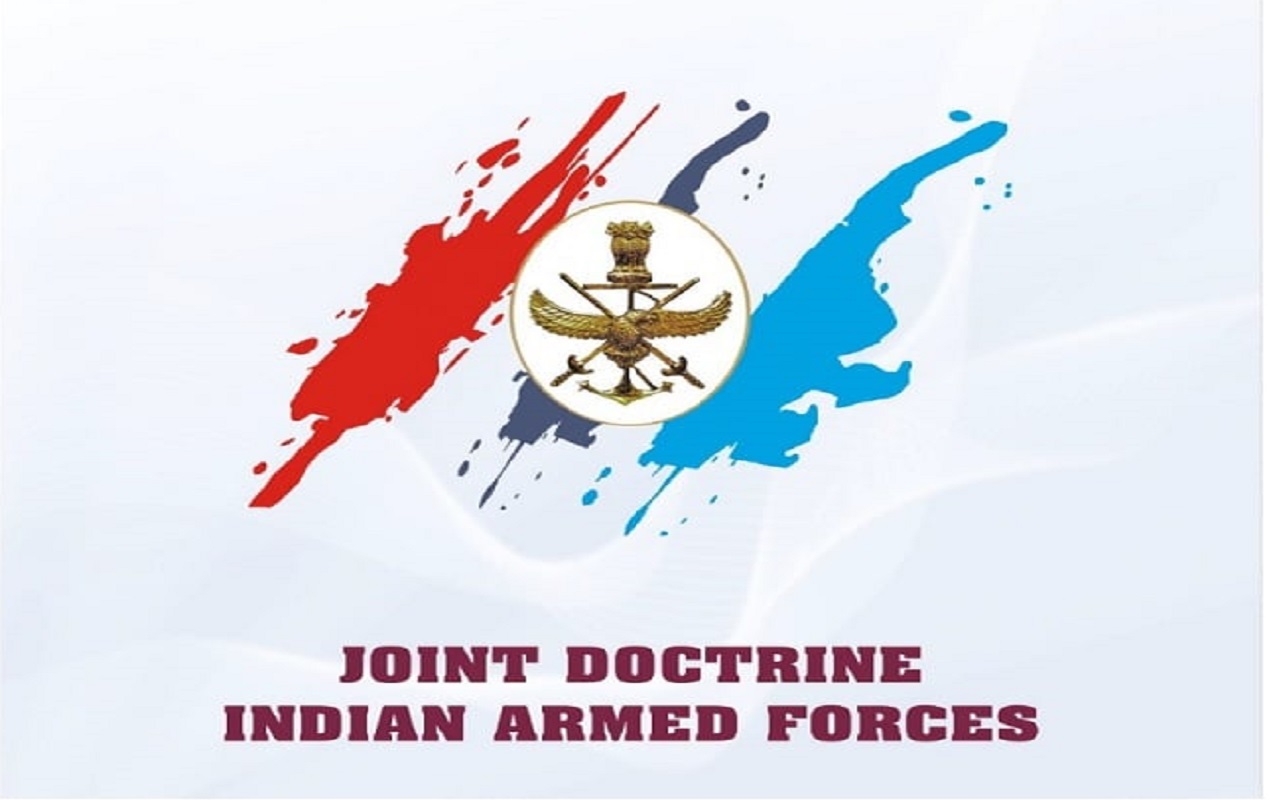Modern warfare dictates different Services and indeed different components of national power to be brought together intelligently to achieve unity of command and unity of effort. Modern warfare is also extremely complex, and no two wars can be stated as being similar.
Doctrine is a body of carefully developed, sanctioned ideas which has been officially approved or ratified under common frame of references. Language of policy, strategy and doctrine is very important. In effect joint doctrine sets out the fundamental principles that guide the employment of military forces in coordinated action towards the common objective and includes terms, tactics, techniques, and procedures (in classified or unclassified form). However, in own armed forces peacetime innovation would have to be top-down through intellectual, doctrinal, strategical and structural changes in response to changing perception of the security environment, inevitably with push and concurrence of civilian leadership.
The 2nd Edition of Joint Doctrine of the Indian Armed Forces – 2017 was aligned with the previously issued Service Specific Doctrines! 'Joint' military doctrine ought to provide the foundation for greater integration and interdependence and achieve higher inter-operability and compatibility within the Armed Forces. As and when need is felt, the revised or updated Joint Doctrine should provide the foundation, for Services to operate in synergy.
The three Services have distinct cultures, ideals, organisations and capabilities. The Services tend to enhance their own tools and solutions, and develop doctrines that promote their own interests. Service Specific doctrines ought to describe and guide proper use of combat power of that Service in military operations to achieve the Joint Force commander’s objectives. Assuredly, the separate domains require exploitation of different sets of physical laws to operate in, but must be intricately linked by the effects they can produce together. However, a service-specific doctrine MUST NOT BE stand-alone, or pre-empt, it has to flow out of the Joint or Integrated Doctrine, through National security policy objectives and strategy. Service Specific Doctrine before the issue of joint doctrine will exactly be cart before the horse!
The basic question that needs to be addressed is what is one Services’ mission within the integrated force? And to do that how should the Service approach it? Contextually, there exist five rationales for enunciating fresh doctrines.
First, Indian strategic geography has clear diktats, of contested borders, of two adversaries of different calibre, and of collusion among adversaries. Indian structure of relations with Pakistan and China has remained anarchic. The happening on the Northern Borders since May 2020 have gravelly affected Indian military posture, exhibited new and bold National Will and initiated extensive rethink. It is apparent that border resolution with both adversaries is not on the horizon, and tensions will persist. Though conventional war is NOT inevitable, and all efforts must be made to avert it, yet peace is too fragile and not guaranteed. Realism for India is, that the balance of power has been severely disrupted in China’s favour and this unbalanced power wielded by China is a potential threat to India.
Hence, if there is a constancy of threat, it must produce a firmness of policy change, and conjoined combat power and not three combat forces. Reconsideration of the doctrines will be necessary.
Second, in India an ambitious agenda was set for the first CDS in 2019, to reorganize the Indian armed forces into integrated theatre commands as a major mandate. India’s system of jointness is ill-suited to adapt to the changing, dynamic, multi domain and hybrid operations, where decision cycles and reaction times are compressed and each layer of response will have to be coordinated as it may lie in different domain. There is need to graduate to `Integration’, that is, institutional combining of constituent elements into a single formal structure, with representation of all services, domain specialists and representatives from relevant non-military domains, because of the change in the scope and the context of wars.
Since the appointment of the new CDS in India in October 2022, the issue of Theatreisation has again found traction. There had been previously inter-Services differences. Indeed, there is no apparent roadmap out for the implementation, though seemingly, there is serious consideration underway. In this manner ‘One Front One adversary’ will convert into right measure of combat power.
Third, the Russian integrated air-land warfighting and aerospace strategy in Ukraine over the last year of war has been constantly questioned. The initial offensive operation and subsequent withdrawal from Kyiv, the deception at Kherson and Ukrainian offensive at Kharkiv, the withdrawal Russian forces from Kherson and the Russian inability to thwart the effectiveness of precise long range artillery HIMARS exhibited the proverbial dichotomy on employment of air power and ground operations to a singular plan. In the initial few days of the war, Russian aircraft flew nearly 140 sorties a day (in March 2022 up to 300 a day) for Counter Air and SEAD campaign, targeting Air Defence radar sites and surface-to-air missile (SAM) sites. It is apparent that Russian Air Campaign was unsuccessful on many faulty assumptions.
The Ukrainian Ground based AD (GBAD) had prepared well and was remarkably creative to combat the Russian air forces. Trained and equipped by NATO and the US, Ukraine proved that by dispersal of capabilities and their imaginative and innovative solutions, its GBAD had undetectable footprint. The Russian low-flying fighters faced major attrition from man-portable air defence systems (MANPADS). Very large number of US-made short-range Stinger SAMs made low-level flying a high casualty endeavour. A strong air power had been made powerless! Indeed, NATO’s sharing of real time radar and intelligence picture would have helped. A lesson to be studied from the air war is the credibility to suppress/ fix/ kill modern mobile SAMs and pop-up threats.
The question of air dominance or air denial is pending! In a contested air space and air littoral environment, with limited SEAD and deep strike missions, establishment of air control may become difficult. Will air denial be the main focus of warfare? There were also fault-lines in ISR at the Kharkiv front where enmassing of Ukrainian Forces was not deciphered, and caused second withdrawal! As a consequence counter surface forces operations have been a casualty, and Russian Forces had to suffer a demoralising withdrawal from Kyiv and Kharkiv! Obviously the Russian air-land war was not a singular war conducted thus exhibiting failure of Joint doctrine, if one existed!
Fourth, India’s surface-centric security focus has its logic due to hot disputed borders with two adversaries and the Northern neighbour’s apparent expansionist, revanchist agenda on territorial and maritime frontier. The onerous responsibility of sovereignty and territorial integrity has been tasked by the Nation to the Services, conjointly. The Services have to undertake a conjoint campaign, and not only contribute to defence of national territory, maritime areas, and other relevant domains.
Control of the air is the right priority as it is considered vital for execution of the overall military strategy, permitting own air and surface forces to operate more effectively in the battlespace and denies the same to the enemy. However, CSFO also demands similar prioritisation and emphasis, due to the adversary’s expansionist designs. Delay in singularisation of campaign, ‘...once some degree of control of air is achieved, the subsequent air and surface operations can be coordinated’ may become detrimental.
Fifth, military commanders have to ensure that national security policy governs the employment of military power and thus tailor their operations accordingly. In Indian context, national security policy has been laying down constraints or modalities for conduct of wars, or insurgencies/ counter terrorism. Constraints have been like no offensive use of air power in 1962 War, or no crossing the LOC in Kargil War or broad rules of engagement in No War No Peace (NWNP) – like minimum force. As post-script, historians or defence analysts may rightly question such constraining national policies, which changed the course of war-history. Yet, it is obvious the political judgement is based on larger number of inputs, some assumptions, an analysis of escalatory-matrix, many diverse criteria and also recommendations/ options of the armed forces hierarchy.
A military campaign will ever remain for political ends. Inevitably, evolution of military plans is two-way traffic between the Government and the military professionals, in which, in a democratic dispensation like ours, the final call will rest with the Government, as the Government is responsible to the peoples of India. Making of a military strategy is a complex bureaucratic process – bureaucracies of civilian and military realm. It is possible that the political hierarchy/bureaucracy considers the military as rigid, hawkish, a little too offensive minded and with unrealistic plans. The Services therefore have to adjust their doctrines in accordance with the political vision.
Practically, military leaders need to develop strategies for armed conflict as an instrument of national (political) policy objectives. National (defence) policy ought to direct or instruct what is to be accomplished that is the end-state within laid down terms of reference and constraints. It is the military strategy that defines how combat power is to be applied, and operations are to be conducted to accomplish national policy objectives. Strategy becomes that continuous process of developing and applying ways and means to overcome particular challenges and achieve strategic ends (objectives). Doctrine is about warfighting, which then presents codified best practices based upon analysed experience and wisdom, on how to accomplish military goals and objectives.
In sum, do Indian Armed Forces require new doctrines? Indeed, they do, doctrine is the linchpin of successful military campaign. Doctrines are a vital, iterative investigation and are studied and analysed word-by-word by own forces, friendly and unfriendly forces alike. It invariably is designed to encourage debate and introspection. Debate is the heart of doctrine. Imperative at the outset is Joint Warfighting Doctrine, which is absolutely essential to guide theprojected campaign, the capability development and the shape of integrated theatre commands. Such a foundational document will lead to individual services carrying out integrated operational planning based on common perception and understanding of threats and the best way to overcome them. A joint doctrine would give clarity to the three services and the defence industry on the capabilities required to be developed. Service-specific doctrines must naturally flow out of the joint conceptualisation.
(The paper is the author’s individual scholastic articulation. The author certifies that the article/paper is original in content, unpublished and it has not been submitted for publication/web upload elsewhere, and that the facts and figures quoted are duly referenced, as needed, and are believed to be correct). (The paper does not necessarily represent the organisational stance... More >>
Image Source: https://defenceforumindia.com/attachments/jdia-jpg.15538/










Post new comment